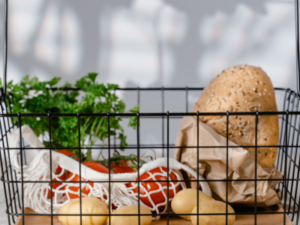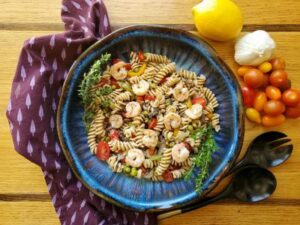
April is Earth Month, and although there are countless ways to show the planet some extra love this month, Oldways is using what we know best: food!
In the United States alone, more than 80 million tons of food go to waste annually. Although the food industry is responsible for nearly half of this waste, the rest comes from consumers. It can sometimes be easy to throw away foods without thinking twice, we hope these tips will encourage you to look at the perishables in your kitchen with a more deliberate eye:
 1. Plan your meals before you grocery shop: Meal prepping is a great way to be deliberate about the ingredients you pick up at the store, especially the perishable ones. Oftentimes, grocery shopping without a plan for how to use said groceries can result in impulse purchases going unused. Meal prepping combats that, and as a bonus, it can get you excited for the delicious meals in your future. Bonus! You’ll save money.
1. Plan your meals before you grocery shop: Meal prepping is a great way to be deliberate about the ingredients you pick up at the store, especially the perishable ones. Oftentimes, grocery shopping without a plan for how to use said groceries can result in impulse purchases going unused. Meal prepping combats that, and as a bonus, it can get you excited for the delicious meals in your future. Bonus! You’ll save money.
Now, that’s not to say you can’t base some groceries off what’s on sale or even what you feel like in the moment – as long as you have a vision for how you can use the ingredient, you’ve already cut down on the likelihood of it ending up in the trash.
Plus, when you get home with your groceries, make sure to put the newest items in the back of the fridge and move old items up so they get used first!
 2. Get creative with those back-of-fridge veggies…: Try to use up the produce that’s about to go bad by making versatile soups, or salads. You can discover something delicious, and you feel good knowing you didn’t waste food or money!
2. Get creative with those back-of-fridge veggies…: Try to use up the produce that’s about to go bad by making versatile soups, or salads. You can discover something delicious, and you feel good knowing you didn’t waste food or money!
The beauty of heritage diets is that they introduce you to worlds of flavor combinations you may have never considered. Try looking up chopped salads or blender soups that integrate the ingredients you have on hand, and you may find yourself surprised at how versatile the ingredients you have on hand can be when you allow yourself to venture out of your normal flavor profiles. Bonus again! You’ll save money.
Additionally, don’t be afraid to tweak recipes if you don’t have everything required. Think of it as a way to flex your creative muscle in the kitchen – and if you need some guidance along the way, check out Oldways’ 12 Ways to Use Vegetables book!
Italian Clean-the-Fridge Chili
 3. …and that means the whole veggie (and fruit!): What do carrot and beet greens, broccoli stems and orange peels all have in common? They’re usually the first things to be thrown away when cooking. Throwing these “scraps” away has become so normal that it’s not common to even think twice about it.
3. …and that means the whole veggie (and fruit!): What do carrot and beet greens, broccoli stems and orange peels all have in common? They’re usually the first things to be thrown away when cooking. Throwing these “scraps” away has become so normal that it’s not common to even think twice about it.
There are so many ways to use these bits and pieces in savvy, delicious and nutritious ways. Carrot greens can be used in place of parsley, citrus peels can be candied or made into zest, and broccoli stems can be cooked just like the florets.
Additionally, peels, skins and rinds are some of the biggest constituents of food waste. Discarding them not only destines them for the landfill, but you’re tossing out key nutrients (especially fiber!), as the peels contain some of the plant’s phytochemicals, fibers, antioxidants, vitamins and minerals. Just be sure to wash and rinse your vegetables well, and you’re good to go.
 4. Embrace imperfect fruit: It’s easy to see a piece of fruit that doesn’t look as appetizing as the rest and throw it away without thinking twice – but that adds up in terms of nutrition and dollars lost! If fruit is bruised or berries are mushy, don’t view them as ruined. Instead, view them as ideal for other things!
4. Embrace imperfect fruit: It’s easy to see a piece of fruit that doesn’t look as appetizing as the rest and throw it away without thinking twice – but that adds up in terms of nutrition and dollars lost! If fruit is bruised or berries are mushy, don’t view them as ruined. Instead, view them as ideal for other things!
You can freeze them to use later in baking or to create delicious compotes and jams. Alternatively, you can throw them all into a blender to make a smoothie – it’s like the flaws were never there!
5. Use dinner leftovers to inform your lunches: Instead of throwing away the last bits of dinner that don’t seem to be enough to warrant leftovers, consider creating something new with them. For instance, those last few roasted veggies and bites of salad can come together in a delicious bowl atop a whole grain of your choice. Top that with some nuts or seeds, canned beans, Greek yogurt, or a sprinkle of traditional cheese and you have a nutrient-packed lunch ready to go!
 6. Utilize frozen produce: Frozen foods – especially when it comes to perishables like fruits, vegetables and proteins – are amazing options when it comes to reducing food waste. Not only can they be more affordable than their fresh counterparts, but they have a much longer lifespan, too.
6. Utilize frozen produce: Frozen foods – especially when it comes to perishables like fruits, vegetables and proteins – are amazing options when it comes to reducing food waste. Not only can they be more affordable than their fresh counterparts, but they have a much longer lifespan, too.
For example, spinach has a reputation for being difficult to finish before it begins to go bad – that problem can be avoided by buying it frozen. Plus, frozen fruits and vegetables are sometimes unfairly demonized for having fewer nutrients, but new research is showing that while this is sometimes true for certain nutrients, others are actually boosted through the freezing process!
Healthy Pasta Meal a la Freezer
Ultimately, there are so many ways to be both health- and Earth-conscious from the comfort of your kitchen. Just implementing a handful of these tips can help you cut back on food waste and hopefully get more creative in the kitchen, too!


Leave a comment